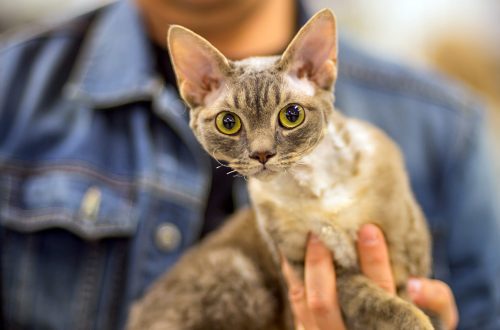
How to properly wash a cat. Rules and life hacks
Contents
- How often should you wash your cat
- When should you bathe a cat?
- Bathing contraindications
- Preparing to wash the cat
- How to properly wash a cat
- Drying wool after bathing
- How to wash a cat that is afraid of water
- How to wash the eyes and clean the ears of a cat
- Features of washing cats of different breeds
- Bathing the cat before the show
How often should you wash your cat
Cats do not need to be bathed daily or weekly, bathing once every 1 months is considered normal. Watching the cat, it is easy to notice that in her free time from games and food, she likes to “beautify” – she licks her fur, paws and tail. The animal maintains the purity of the coat on its own, so it does not need regular bathing. Moreover, washing too often can harm the cat, as the pet’s subcutaneous glands produce a protective lubricant. The substance is distributed throughout the coat, makes the hairs silky, and also serves as a barrier against bacteria.
An interesting fact: cats and cats take care of themselves in different ways. Cats spend more time licking their fur and do it more thoroughly than cats.
It is important to distinguish between shampooing your cat thoroughly and rubbing certain areas of the coat as it gets dirty. If the cat is smeared in the toilet or came home from the street, wipe off the dirt with a soft cloth previously moistened with warm water. This will not harm your pet.
It is necessary to teach a kitten to wash from the age of 4-5 months, so that bathing becomes a familiar ritual, and, as an adult, he would not experience fear of water. In any case, you will have to wash a domestic cat throughout its life, because its hair gets dirty and falls off, but you really want the “fur coat” to always be luxurious and well-groomed!
When should you bathe a cat?
Bathing a cat or a cat is necessary only if there are good reasons for it. Indications for washing a pet:
- more than 2-3 months have passed since the last bath, and the cat’s coat has become dull, darkened, with tangles;
- the cat is very dirty, for example, lying in the mud or doused with paint;
- if parasites are found in the wool, you should immediately bathe the cat, and then treat the “fur coat” with an antiparasitic agent. Especially carefully it is worth examining cats, which are often on the street and can “catch” ticks and fleas;
- washing may be recommended by a veterinarian if a cat develops allergies, lichen, dermatitis and other skin diseases;
- if you found a kitten on the street and decided to take it into the house, then you can’t do without water procedures;
- as part of the preparation for the exhibition, you will have to wash the cat with a special shampoo and make the pet “styling”.
Bathing contraindications
In some cases, you can not wash the cat:
- during rehabilitation after surgery. Usually, full recovery takes about a month, but it all depends on the degree of intervention in the body and the health of the pet;
- late pregnancy. Washing can be very stressful for a cat and even provoke premature birth;
- within 2 weeks after vaccination. The cat’s immunity is weakened, and it is better to postpone washing;
- if the animal is sick, bathing can aggravate its condition. Cancel water procedures and be guided by the recommendations of the veterinarian.
Preparing to wash the cat
Trim your cat’s nails to prevent him from scratching you while bathing.
Comb the coat and remove tangles.
Choose a place for bathing – a bathtub, a sink or a basin. The bathtub is perfect for large cats, it is only necessary to cover the bottom with a non-slip mat. Many owners wash their pets in sinks. The option with a basin is less convenient, since the cat may begin to grab onto its edges, give preference to a container with a volume of about 30 liters or buy a special bath.
Remove all foreign objects from the sides of the bathtub or sink, hide washcloths and other things that the cat can catch on.
Make sure you have everything you need to bathe your pet on hand:
- a shampoo selected specifically for a cat (laundry soap and detergents for people will not work – cats have a different skin Ph);
- a hat that covers the cat’s ears, or cotton swabs that can be put in the ears, or you can tie a small bag on your head like a scarf;
- soft washcloth for washing the head;
- a large towel in which you can wrap the cat after washing so that it does not freeze and cannot scratch you;
- a standard towel for collecting moisture and drying residues;
- caring assistant (desirable).
Check the temperature in the room where you are going to wash the cat. Pets can easily get cold and get sick, so the air should not be colder than +22 °C.
Pour water into a tub, basin, or sink beforehand. The cat is more afraid not of the bath itself, but of the sound of water pouring from the tap. Before starting water procedures, draw warm water at a level of about 10 cm so that the water reaches the cat’s stomach. The animal should stand confidently on its paws, but so that its head does not get wet. By the way, you can also pre-fill a watering can with water, with which you can then wash off the foam from your pet if he is afraid of the shower. The water temperature should be 38-40 °C. If you don’t have a thermometer, dip your arm up to your elbow in the water. If you can’t feel the water, then it’s suitable for the cat.
How to properly wash a cat
Until the water has cooled down, and the cat has not suspected something was wrong, grab it and carry it to the bathroom. Talk to the purr affectionately, do not make sudden movements that could scare your pet. Do not forget to close the door – in case of an escape, the cat will be difficult to catch, and wet footprints will remain throughout the apartment (perhaps along with foam, if you have time to lather the cat).
Gently place your cat in a tub, basin, or sink. During the dive, you can hold it by the collar so that the pet does not break out and scratch you. Put a bathing cap on him or put cotton swabs in his ears. Water the coat with warm water, avoiding getting into the eyes, nose and ears.
It is likely that the cat will be unhappy and will begin to resist. She’ll have to persevere – for her own good. Grasp the cat’s shoulders directly under the chest in your left hand if you are right-handed. Thus, the dominant hand will remain free, and with its help it will be possible to lather the animal. If the cat swings its hind legs, then you just need to plant it and hold it so that it cannot jump and kick.
At this stage, the assistant will greatly facilitate your task – he can water the cat from a watering can or shower, give shampoo, a towel and other necessary items, and you will do all the manipulations with your free hand.
Note: pet stores suggest using a short leash with suction cups for bathing a cat. It makes sense to use this accessory only as a last resort, since the pet may be more afraid of the leash than washing, and in the future it will be difficult to lure the cat to water procedures.
Now, with light massaging movements, apply shampoo to the wet cat hair. Soap your back, chest, stomach and tail in succession, don’t forget about the paws and chin. Do not use too much shampoo, so that you do not have to wash off the lather for a long time.
Using a special washcloth, gently wash the cat’s face. If you want to wash the cat’s head, ask the assistant to cover his ears or put cotton swabs in them. Also, make sure that water does not get into the cat’s nose.
It’s time to thoroughly rinse the cat’s coat. Rinse the foam strictly from top to bottom. It is convenient to rinse the shampoo with a hand shower, just do not lift it very high. The remains of the detergent should not remain on the cat’s skin, as this can later lead to irritation.
If you are rinsing your pet’s coat with a basin, consider its length. For a short-haired cat, one basin will be enough, while for a long-haired cat, several.
Important: you can not wash the cat after feeding and dip it in water with its head.
When the shampoo is washed off, take the purr out of the water, wrap it in a large towel and hug your “cocoon” for a few minutes. The cat should come to his senses and calm down.
Drying wool after bathing
Take the freshly washed cat to the room and dry it with a towel. For short-haired cats, one towel will be enough, and for long-haired cats, do not regret 2-3 pieces. You can put your pet on a newspaper or chopper so that the flowing moisture is absorbed faster.
For your information: a cat has a so-called air cushion between the skin and the top layer of wool. This layer of air is heated by the body heat of the animal and protects the cat from freezing. During bathing, the coat gets wet and loses its thermoregulatory feature for a while, which is why it is so important to warm the cat with towels after washing and protect it from drafts.
If the cat is not afraid of a hair dryer, then about 10 minutes after bathing, you can slightly dry his coat. The air flow should be warm, but not hot. If the cat is afraid of an electrical appliance, it is better to wait until the “fur coat” dries naturally.
For combing wool, use a special comb.
After washing, a domestic cat needs to be warm for at least an hour.
How to wash a cat that is afraid of water
What to do if the cat is afraid of water? Is it really necessary to completely abandon bathing? This problem is solvable – be patient and ingenious.
Firstly, do not neglect trimming the nails before washing, because during bathing, especially impressionable cats become very warlike.
Then play well with the cat so that he relaxes and gets tired. You cannot feed your pet.
Having lulled the vigilance of the mustachioed-striped one, proceed to washing. You need to lower the cat into the water gradually, distracting him with toys. Water must be poured in advance so that the cat does not wait extra time and is not afraid of an unusual sound.
No matter how the cat behaves during the wash, it does not need to be shouted at or physically punished – this will only bring the animal additional stress. To restrict movement, you can use a special bathing net, where the cat is placed, like in a bag, and does not go anywhere. Maybe she will remind him of his favorite box?
Give your cat a treat when you’re done bathing so she knows she’ll be rewarded for bathing!
If your pet is still unable to overcome the panic fear of water, you can wash it with dry shampoo. This is a great alternative to traditional shampooing as a good dry shampoo cleans almost as well as a liquid shampoo. Apply the powder to the cat’s fur, wait a minute and comb the powder along with the dirt.
How to wash the eyes and clean the ears of a cat
So, even the most capricious cat is washed, but while bathing, we bypassed the eyes and ears, and they should also be clean.
The cat’s eyes are wiped with a cotton swab dipped in clean boiled water or a weak solution of tea or chamomile. The movements should be light, no need to press on the eyes and rub them.
It’s time for the ears. Without the need to clean them is not necessary – only if they are dirty. However, after washing the cat, water could get into the ears. You need to wipe the outer part of the ear with a cotton swab, on which it is better to twist an additional layer of cotton. Use a clean stick or dip it in a drop of petroleum jelly. Water and other liquids must not be used. As a rule, cats love to clean their ears and are happy to expose them to their owner. Healthy cat ears should be pink, clean, and odor free.
Features of washing cats of different breeds
Some pedigreed cats have wool characteristics, which is reflected in their care. In general, we can say that long-haired cats have to be washed more often than short-haired ones.
A common myth has touched the sphinxes – supposedly because of their oily skin they need to be washed once a week. In fact, it is better to wipe the sphinx with wet wipes or a soft cloth, and bathe only if it is very dirty.
The Burmese cat has a very showy, shiny, short coat, the beauty of which needs to be maintained. Instead of washing the fine wool, after which the cat can become like a hedgehog, wipe it daily with a piece of chamois or a damp cloth. This will help give the coat a glossy sheen. Once a week, the cat should be combed out with a mitt or brush. You can use a special cat antistatic. This massage is sure to please your chocolate!
British and Maine Coons have sensitive skin, so it is extremely important for them to choose specialized shampoos for their coat type. From poor-quality cosmetics, cats can begin to constantly itch and get dandruff.
Bathing the cat before the show
Before participating in the exhibition, any domestic cat will have to be washed. Such a bath will have some features:
- you need to wash the cat before the show 2 times, with the second soaping, a tinted shampoo (or balm) is used, selected depending on the color;
- the foam is also washed off 2 times, first with water, then with rinse aid or a weak solution of vinegar;
- during blow-drying, the hair is smoothed with a massage comb with an antistatic coating of teeth, starting from the back and ending with the collar;
- now, on a still slightly damp “fur coat”, you can apply powder, which will absorb the remaining moisture and make the coat smooth;
- after a couple of hours, complete the treatment of the cat’s coat by applying a protein conditioner.
Life hack: how to choose a tinted shampoo for cats of different colors
White pets are washed 2 or even 3 times with shampoo intended for white cats. When reapplying, leave the shampoo for 2 minutes for a deeper effect, and then be sure to rinse it off well. White shampoo is also suitable for chinchilla and silver marble cats, but you do not need to leave detergent on the coat. If a cream, blue, or lilac cat looks a bit dark to you, use the same shampoo to lighten the brighter shade.
Cats with rare red, tortoiseshell and merle colors should be washed with a red or bronze shampoo. If the cat has a chocolate coat color, add a few drops of black to the bronze shampoo. Fluffy beauties of black colors are suitable for black shampoo.
Follow the instructions and your cat will outshine all its relatives at the show!





